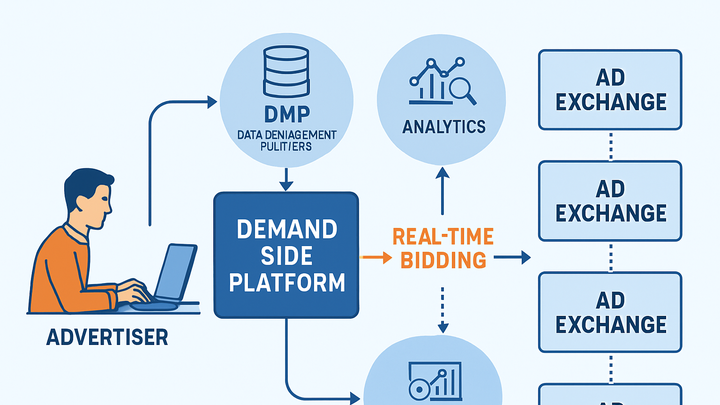Published on 2025-06-22T07:32:45Z
What is a DSP (Demand Side Platform)?
In digital marketing, a Demand Side Platform (DSP) is a centralized system that automates the purchase of digital ad impressions across various ad exchanges and supply-side platforms. It harnesses real-time bidding (RTB) to evaluate incoming bid requests, match them with campaign targeting rules, and submit bids—all within milliseconds. DSPs unify audience data from first- and third-party sources via integrations with Data Management Platforms (DMPs), enabling granular targeting and dynamic creative optimization. Advertisers can set budgets, control bid strategies, and monitor performance through built-in reporting or by exporting data to analytics tools like Google Analytics 4 (GA4) and cookie-free platforms such as PlainSignal. As privacy regulations evolve, DSPs are also incorporating cookieless tracking solutions and privacy-centric identifiers to maintain accurate measurement and optimization.
Dsp (demand side platform)
A Demand Side Platform automates the purchase of digital ad inventory via real-time auctions, enabling precise targeting and optimization.
How DSPs Work
This section explains the core mechanics behind a Demand Side Platform, including the flow from bid request to ad delivery in real time.
-
Bid request and real-time bidding
When a user visits a website, the publisher’s SSP sends a bid request. The DSP evaluates the request based on targeting criteria and responds with a bid—all within milliseconds.
-
Bid request data
Contains user info (e.g., device type, location, browser), page context, and inventory price floor.
-
Bid response
DSP returns bid price, ad creative, and tracking URL. The highest bid wins the ad slot.
-
-
Audience targeting
DSPs leverage data from first-party and third-party sources to match ads with specific audiences in real time.
-
First-party data
Data collected directly from your website or CRM, such as past purchasers or newsletter subscribers.
-
Third-party data
Purchased segments from data providers, such as demographics, interests, or purchase intent.
-
Contextual targeting
Matching ads based on the content of the page rather than user cookies.
-
-
Optimization and reporting
DSPs implement algorithms and machine learning to optimize bids for conversions, clicks, or viewability, providing dashboards and reports for analysis.
Key Features of DSPs
Core features that distinguish a DSP and empower advertisers to run efficient programmatic campaigns.
-
Real-time bidding (rtb)
Automated auctions that occur in milliseconds across multiple ad exchanges.
-
Cross-channel buying
Capability to purchase inventory across display, video, mobile, native, and connected TV.
-
Budget & bid management
Tools to set budgets, control spend pacing, and adjust bids based on performance.
-
Dynamic creative optimization (dco)
Automatically tailor ad creative elements (images, copy) to different audience segments.
Integrating DSP with Analytics and Tracking
Combining programmatic ad data with analytics platforms ensures accurate performance measurement and optimization.
-
Tracking with google analytics 4 (GA4)
Use GA4 to monitor traffic driven by your DSP campaigns by tagging ad URLs with UTM parameters and defining conversion events.
-
Utm parameters
Append utm_source, utm_medium, and utm_campaign to ad URLs for precise channel attribution.
-
Conversion events
Configure GA4 events such as purchase, sign-up, or demo request to measure ROI.
-
-
Cookie-free analytics with PlainSignal
Implement PlainSignal’s lightweight script for privacy-compliant analytics when cookies aren’t available.
-
Setup code
Add the following snippet to your page’s <head> to start collecting analytics data:
-
Code example
<link rel="preconnect" href="//eu.plainsignal.com/" crossorigin /> <script defer data-do="yourwebsitedomain.com" data-id="0GQV1xmtzQQ" data-api="//eu.plainsignal.com" src="//cdn.plainsignal.com/plainsignal-min.js"></script>
-
-
Roi measurement and data import
Export DSP spend and performance metrics to your analytics or BI tool to calculate cost per acquisition and lifetime value.
Benefits and Challenges
An overview of the main advantages and potential pitfalls when using a DSP.
-
Benefits
DSPs offer automated buying, precise targeting, and scalability.
-
Efficiency
Automates manual ad buying tasks, saving time.
-
Scalability
Access to multiple ad exchanges and inventory sources.
-
Performance
Data-driven optimization improves ROI.
-
-
Challenges
Advertisers must navigate complexity, data privacy restrictions, and ad fraud risks.
-
Complexity
Steep learning curve to configure targeting and bid strategies.
-
Privacy & compliance
Regulations like GDPR and CCPA limit data availability.
-
Ad fraud
Invalid traffic or bots can inflate metrics and waste budget.
-
